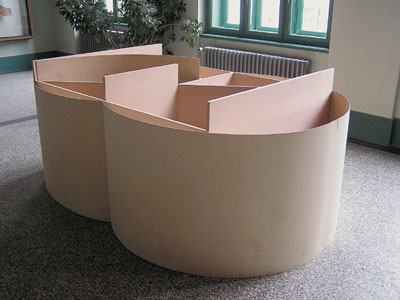| Umělec 2006/1 >> Dominik Lang | Просмотр всех номеров | ||||||||||||
|
|||||||||||||
Dominik LangUmělec 2006/101.01.2006 Jiří Ptáček | new faces | en cs |
|||||||||||||
|
Dominik Lang (1980) lives in Prague, studies at the studio of Jiří Příhoda at the Academy of Visual Arts (AVU) situated in Prague. In general, Lang is interested in “solutions.” He watches how things are being done, what is considered as given (“we accept it and don’t think about it anymore”), and suggests changes and different solutions. Sometimes he strives for a visible change, sometimes for a change that will only become apparent under certain conditions. Clear examples are with the following realizations. Lang goes out on the street with a can of yellow paint and pours it out, carefully onto the street. When you go past, you’d think that someone had spilled the paint. But watch out, from this moment on it holds that not all the stains are the work of fumblers. In other works, he placed another wall in front of the gallery Jelení, he slightly pushes the radiator out from the window niche and shifts the fluorescent lamp out of its axis. In the garden in front of the gallery he moves the plants outside the flowerbed. Those who didn’t know the space or didn’t know about the changes must have left with a feeling that Lang merely emptied the gallery (“Such a cliche! How many times has it already been done?!”).
What is Lang trying to do? His actions often are on the level of unusual personal experience. When he created a replica of Stavby č.II. (Constructions II) by Stanislav Kolíbal, he had to solve a lot of technical problems. But Lang got to know the work and the object from a foreign collection which he had never seen before. Now he could investigate it. Usually we have a different experience with art. Lang based his experience on a laborious but unique approach. Similarly he replicated a photo of Gariel Orozco - a “drawing by a bicycle and the water” he substituted with “a drawing by a car and the water.” Instead of a camera he recorded it with a video camera. In Orozco’s photo we also don’t know who drove through the puddles. Here we can see the whole action. The fact that Lang was the driver illuminates the imporatnce of the creator. It also meets his relation toward the mingling of the intimate and the public, of personal experience and public intervention, of the self and the quoted. Lang uses things and events we often overlook. We think that we know them well and we assume a certain register of possibilities of “what they are, why they are here and how they are created.” We put them into context and we create their logic. But rarely do we count on deliberate imitation of some of the possibilities from the register. Dominik Lang imitates heavily. Only seldom do we expect someone to turn the logic round. We may do so in art, where it is expected most of the time, and that is why Lang is looking for various niches in order to house his own innovations. His objects, made from particle board, can be holistic furniture or minimalistic sculptures. It only depends on the situation. Another work, the minimalist wooden stairs at the staircase of the AVU building, could be construed as being built by craftsmen because of repairs to the building. And thirdly, the plastic waste pipes, which Lang removed from their originally convenient route to a point that led them into the gallery, became a piece of art, but Lang was careful for them not to lose their purpose. Everything you flushed down went though the pipes (and the gallery). Memory has architecture and we are their architects. Single elements in their structure are mutually interwoven. Through the analogies between the remembered and immediate present realities we create interference, from which we conclude this or that. When Lang suspended a clothesline, overloaded with clothes, from the window of the Academy of Visual Arts, the huge building, that for three centuries has boasted the importance of artists’ education, changed its function. It stopped being a vessel for a lot of nameless students and sent a signal about an individual who needs to solve a common situation. The amount of clothes was so big that it would never dry. The person standing outside couldn’t understand right away, but the signal about a common situation was again only a piece of art – a sculpture. Lang freely moves in small zones where he feels the borders between art and everyday contexts. Art practice as we know it—the mainstream of that cultural life—has very firm footholds. Among them are the personas of cultural life. We know what their interests are, with which power they influence their surrounding and with which contexts they create. At an exhibition with Jiří Thýn at Entrance Gallery, they initiated a constitution of a net of relationships between famous celebrities. They did – at the request of the artists – what they do best: one created an installation, another one an invitation, another created the exhibition… They created a context, they became a part of the mechanism of production. And this mechanism was the main exhibited material. The artists remained in the background, arguably. Afterall, the context was created for them.
01.01.2006
Рекомендуемые статьи
|
|||||||||||||








Комментарии
Статья не была прокомментированаДобавить новый комментарий